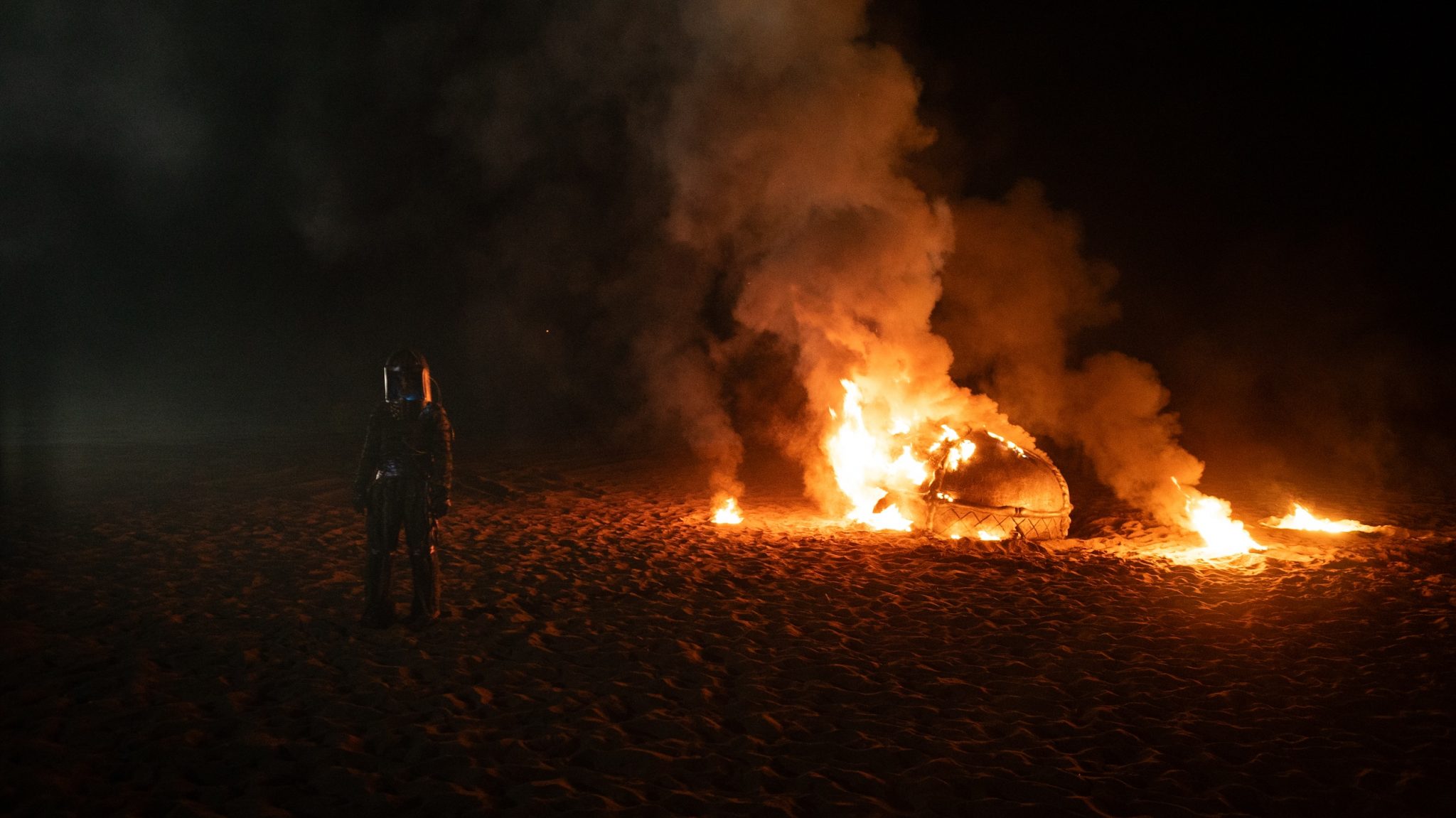The Indonesian artist’s latest videos combine quantum physics and mysticism, opening new portals through which to explore capitalist systems of extraction
In 2022, as part of the Collide Award programme of artist residencies, the Indonesian artist and filmmaker Riar Rizaldi was invited to CERN. There, at the home of the Large Hadron Collider, an apparatus that tests theories relating to particle physics, he began developing Mirage – as part of a larger decade-long project – which explores a dialectics of science and mysticism, modernity and tradition, contemporary thought and historical memory, belief and knowledge.
Mirage – Metanoia (Prelude) (2023) is the project’s first film: an animation that sits somewhere between the styles of a mid-twentieth-century Hanna-Barbera cartoon and a Disney production of an earlier era – think The Jetsons (1962–87) meets Fantasia (1940). In it, two cosmologists drift happily through the Milky Way some 4000 years after the ‘Fansurian Atomist Revolution’, inspired by the writings of Hamzah Fansuri, the sixteenth-century Sumatran Sufi poet and philosopher who believed that god exists in everything – that is, in every particle. Gazing at a distant Earth, the cosmonauts talk about wanting to give “them” – presumably humans – a new life by teaching them to understand “the origin of all” and “encountering god” in particles. One cosmonaut likens the idea to the Sufi concept of Waḥdat al-wujūd, meaning the unity of existence or being, and atomism, an ancient philosophy that sees the universe as an indivisible composition of atoms: two ideas in which science and philosophy coalesce, given the evolution of atomism into atomic theory, and the continued discovery of smaller particles, including the Higgs boson (the so-called ‘god particle’) by CERN in 2012.
What emerges in these reflections is an archaeology of previous futurisms that have evolved into present-day possibilities. “I was interested with this idea of the archaeology of the future when Gunung Padang was discovered,” Rizaldi explains over video call – some believe the site in West Java is one of the most advanced pyramids ever made, while others assert that these are just volcanic formations. But what struck Rizaldi was how the Indonesian state jumped at the chance to put Indonesia on the map by promoting the site. “It’s actually quite inspiring to think about the past as a way to recontextualise the future,” the artist muses. “Or to reformulate that slightly, to think about the future and then work backwards.”



Among the things the cosmonauts discuss in Mirage – Metanoia (Prelude) is the ability for Waḥdat al-wujūd to free magical thinking “from the complexity of psychological interpretation” and its capacity “to observe many things simultaneously and continuously”, as well as how it exists as “one among thousands of other scientific methods”. They describe particles and atoms as a “recursive structure of mathematical-geometric objects”, which “replicate in an infinite number to form the universe we live in today” – just as god “makes the entire universe present and continuously recurring – like a cybernetic machine.” In the end, text on screen outlines perspectives of ‘Tropical Sufi-Atomism’, which emerged in the Indo-Malay archipelago during the fifteenth century: agricultural societies see gods in anything affecting the harvest; animal herders “believe in a single shepherd god”; and those who live in humid landscapes “see god in every droplet – every particle – of dew…”
Rizaldi’s interest in Tropical Sufism developed while living around Merapi (he still resides in the vicinity), the most active volcano in Indonesia and the subject of the short film Pyroclasts Are Eloquent Storytellers (2022), a prelude to his 2023 feature film, Monisme. While the former focuses on the sublime power of the volcano itself, capable of destroying and creating life at any moment, Monisme, which oscillates between documentary, horror and science fiction, explores the communities that exist around it. There are the volcanologists who study the volcano to predict its activity, enthralled and terrified by its capacity to destroy. (In one scene, they discuss the Toba catastrophe theory, which hypothesises that a cataclysmic volcanic eruption 74,000 years ago wiped out most humans on Earth and caused climate chaos.) Then there are the violent, state-sponsored paramilitaries, who bully miners digging for sand around the volcano to service the construction industry, and a documentary filmmaking team led by an artist filming those workers. Finally, there is the Indigenous community, who describe their relationship with Merapi as “direct and inseparable”.
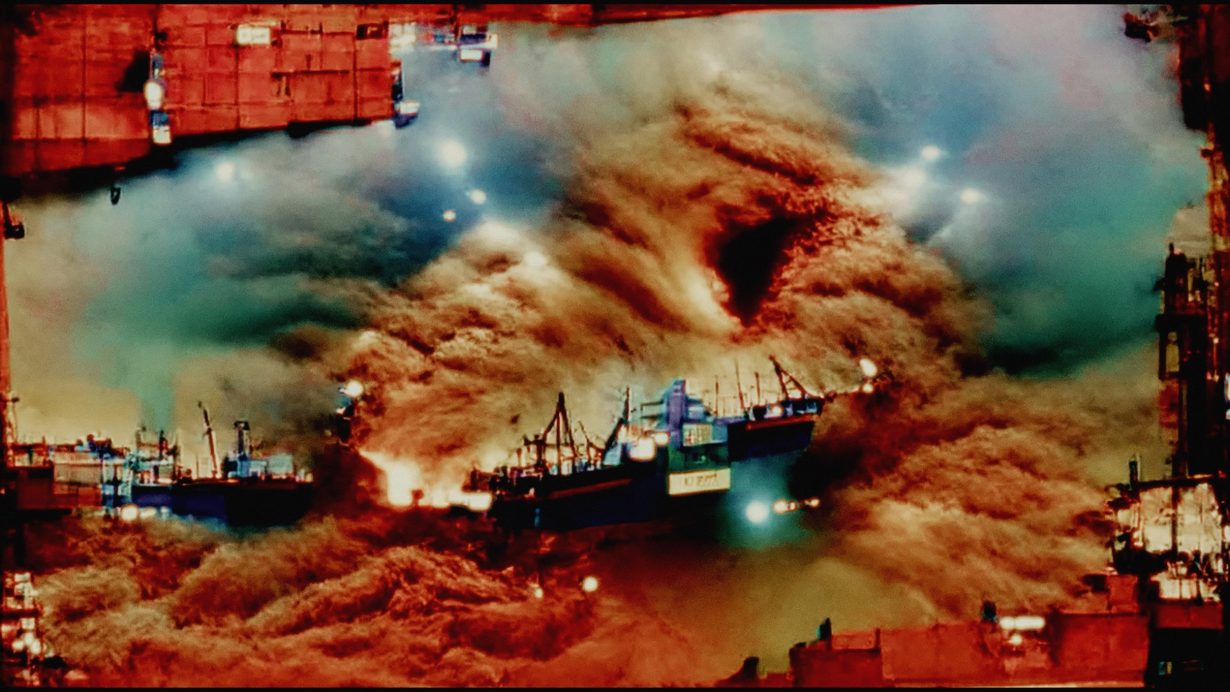
Infused into these works is Rizaldi’s interest in emanation, a theory introduced by the Neoplatonist philosopher Plotinus that considers reality a continuous outflow of things that spring from ‘The One’. Rizaldi likens the theory to the Big Bang: a conception of the universe emerging from a single event and constantly expanding and contracting. Indeed, one encounter can generate a whole trajectory of works for the artist, like his meeting with logistic workers at a shipping company in Jakarta in 2021, which spawned Notes from Gog Magog (2022) and Larung (2024). The former is a film spliced with AI-generated animations of nightmarish workplace accidents, inspired by corporate safety videos, that connect blue-collar Indonesian shipworkers handling Samsung cargo with white-collar Samsung office staff in Korea through ghost stories. The latter is a hypnotic tribute to Indonesian cargo ship crews and their burials at sea: a camp, glam-rock lament with a candy-coloured tint showing three men holding each other as they sway on deck.

Ideas for Mirage were likewise triggered by a meeting. While filming around Merapi, Rizaldi met a member of the Indigenous community who descended from a Sufi mystic. The artist learned that, through the centuries, Sufi mystics in the region retreated to the mountains after their ideas were deemed heretical to monotheism – by sultanate, coloniser or state – where they interacted with Indigenous communities and their animistic beliefs. “Their worldviews somehow collided, and their descendants practice this very syncretic version of Sufism with animism,” Rizaldi notes, describing the existence of graves belonging to Sufi mystics around Merapi dating as far back as the fifteenth century.
“I’m always thinking about evolutions like this in my practice,” Rizaldi explains. “Across my projects, time is always jumping.” Yet everything is connected. The latest episode in the Mirage project, Mirage: Eigenstate (2024), referring to the eigenstate in a quantum system where one variable has a fixed value, reflects these connective jumps by situating Sufi mysticism’s tropicalisation within a broader field of atomisms. References include Greek philosopher Democritus, a younger contemporary of Socrates who embraced atomic theory; the Mu’tazilite atomists of the eighth to tenth centuries; Western thinkers from the twelfth century, for whom god was conceived of as “a sphere whose centre is everywhere” – “a thought that turns out to be not much different from mystical thinkers in the tropics” of the fifteenth and sixteenth centuries; John Dalton’s theory of chemical combination and compound elements; and the Copenhagen interpretation of quantum mechanics.

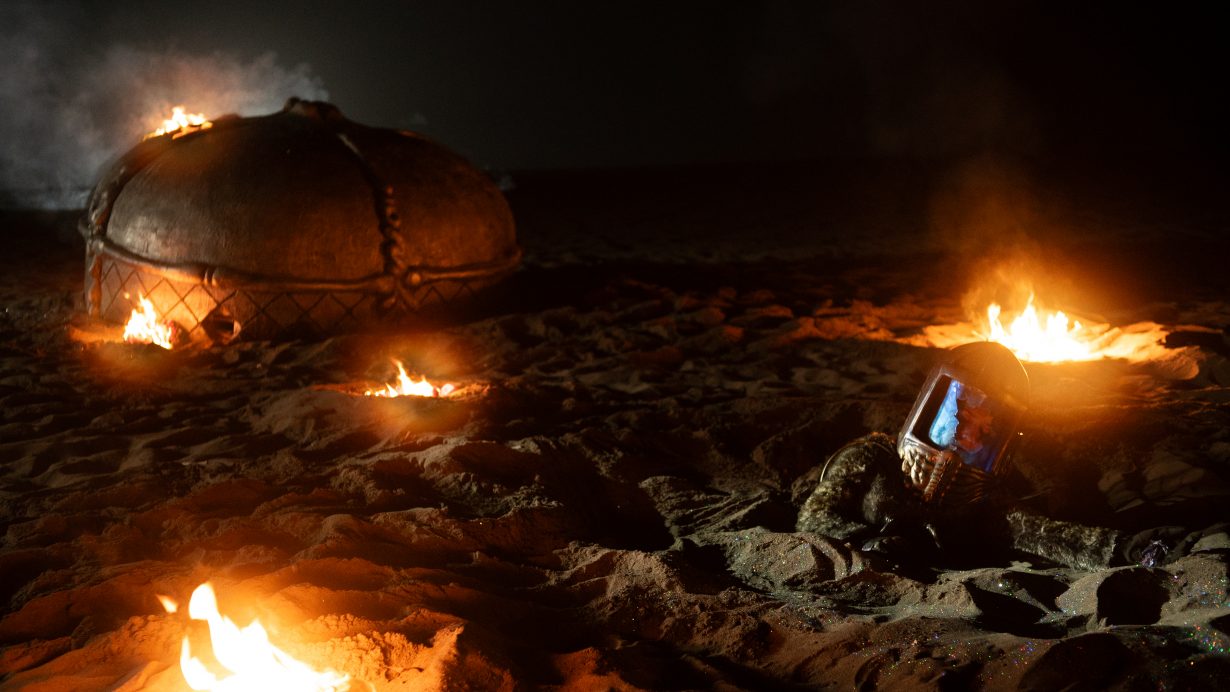
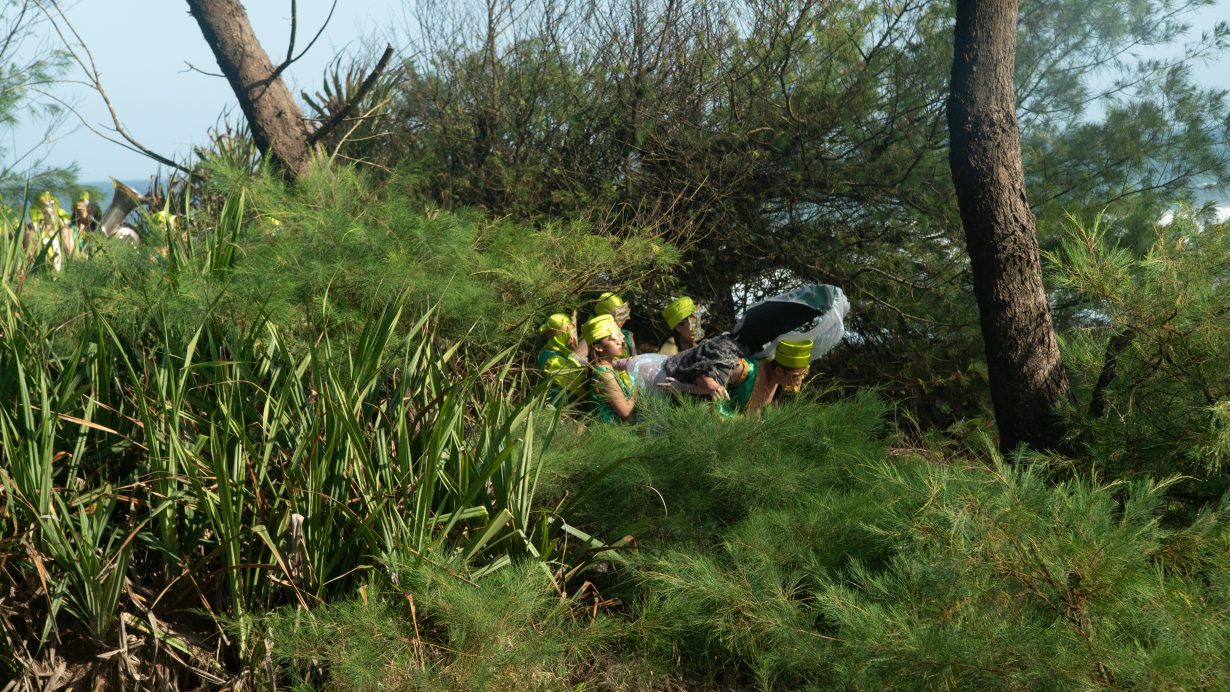
A cross between a science documentary and science fiction film, Mirage: Eigenstate is set 2500 years after the Fansurian revolution, and follows a cosmonaut who crashes into quantum immortality, a thought experiment where someone can survive death by existing across parallel non-interacting realities or timelines, referring to the many-worlds interpretation. Amid the action, rings composing a flashing target periodically cover the screen and invert incessantly to amplify the central circle, creating a constant point amid the unstable whole that visualises the eigenstate’s fixed value – which in Mirage: Eigenstate would be the existence of god in every particle, making god, as the film’s TV presenter points out, reality itself. Each flashing circle feels purposefully hypnotic: an attempt to draw audiences into a many-worlds state of mind that is modelled by the cosmonaut’s arrival in another timeline, where a shaman welcomes her to “a different world” and thus “another particle”. In the end, Mirage: Eigenstate invites viewers to conceptualise the material world as a site of inherent pluralism, by describing quantum mechanics, the science of matter and light on atomic and subatomic scales, as “the most successful scientific theory ever”. That is, “if you simply accept the wave-function collapse”, which theorises that a wave function, a superposition of eigenstates, is “collapsed” into one of its many possible outcomes after a measurement or observation is made. In short, all possible outcomes collapse into a fixed value: an accepted reality.


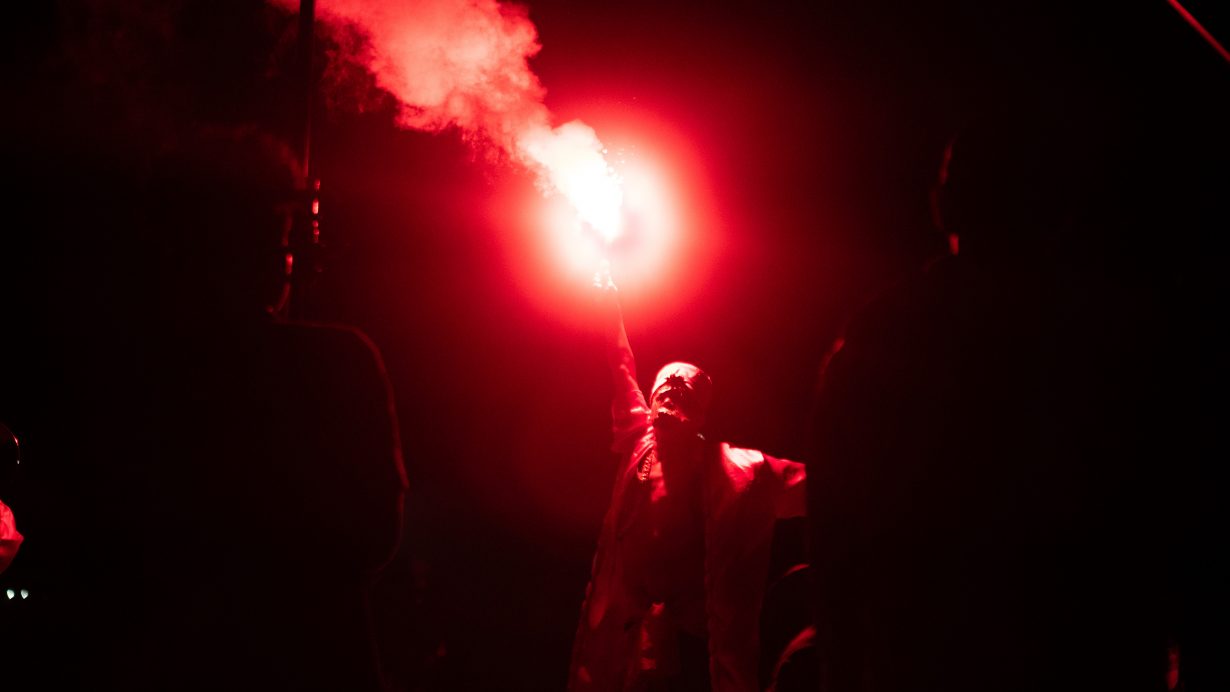
It’s a lot to take in. Even the presenter in the film asks Rizaldi, who has just yelled “cut”, if he’s a genius or if she’s “just completely dumb.” But, as Rizaldi has said, every work evolves out of works that came before it, and there are signposts to be found in earlier films. Take Kasiterit (2019), a short film set in Bangka Island in Indonesia, known for producing one third of the world’s tin supply together with the neighbouring Belitung Island – a crucial material for smart and renewable technology production. Over striking footage of the island’s Kaolin Lake, a former mining site with toxic, turquoise waters and white mineral banks, the voice of a solar-powered AI entity named Natasha describes this as her ancestral homeland. “I come from here,” Natasha says. “This landscape, which is presented to you through projection or screen is made of my body parts: tin.” But Natasha’s body is also made of capitalism, she says: the most primitive form of animism, in that objects are seen as pure, vital material. She supports that fact as an entity imbued with an animated lifeforce, such that she wonders if she would even exist had tin and capitalism never become entangled, and if the material’s value was instead “rooted to the cosmology” of the island’s Indigenous Orang Lom people.
Not quite a ghost in the machine but a material production of the human-driven industry that has literally reshaped the earth from which it emerged, Natasha induces a kind of wave-function collapse by articulating her reality as part of – not separate from – Bangka Island as a material space composed of the lives that inhabit and intersect it. There are Indigenous miners, who are descended from ancestors who once considered the tin unearthed from ritual burnings of agricultural land to be deities, answering Natasha’s question about whether an AI entity like her would exist in the worldview of the Orang Lom (because what is a deity if not an artificial intelligence?); the state-owned mining firm that evolved out of a company created by Dutch colonisers who extracted tin to braze their ships and make tin cans; the tourists who visit the site because of its uncanny beauty; and the island itself, which is doomed to sink once its tin reserves are completely extracted.

Like Merapi, Bangka Island is an entity that exists as a material object, a subject to study and observe, and a metaphysical being in its own right, in Rizaldi’s treatment – an entanglement of conditions that reflects the artist’s interest in the lattice of worldviews that shape Indonesia, the world’s largest archipelago. “My work is about the complexity of different worldviews existing at the same time, especially as it happens in Indonesia, where every island has its own ideas and unifying these many-worlds interpretations is almost impossible,” he explains. Hence the artist’s interest in deconstructing cinema and its genres to make that complexity legible without reducing it to a singular framework. “My interest in deconstructing genre relates to how we think about the world,” he elaborates, “because every genre has its tropes, which is similar to a worldview and its belief system.”
Ghost Like Us (2020) offers a crucial lens through which to understand Rizaldi’s deconstruction. The video essay explores how the New Order regime, from 1966 to 1998, instrumentalised horror movies to manipulate Indonesian society through an ideology of fear, where victories of good over evil were expressed through movies articulating a sharp division between the urban – represented by the military, religious institutions and authority figures – and the rural, framed as backwards, without autonomy, and in need of rescue from evil forces. Even in the Reformation era, which began following Suharto’s resignation in 1998, horror movies maintained a derogatory gaze over the rural, says Rizaldi, until decentralised film technologies like digital cameras and VCDs emerged during the mid-2000s, when peripheral filmmakers began creating films with rural points of view. Ghost Like Us highlights one movie in particular: Misteri Bondowoso (2005), a paranormal, verité-style production conceived by a group of shamans and sorcerers in rural East Java, showing people making contact with ghosts, that circulated through VCD.
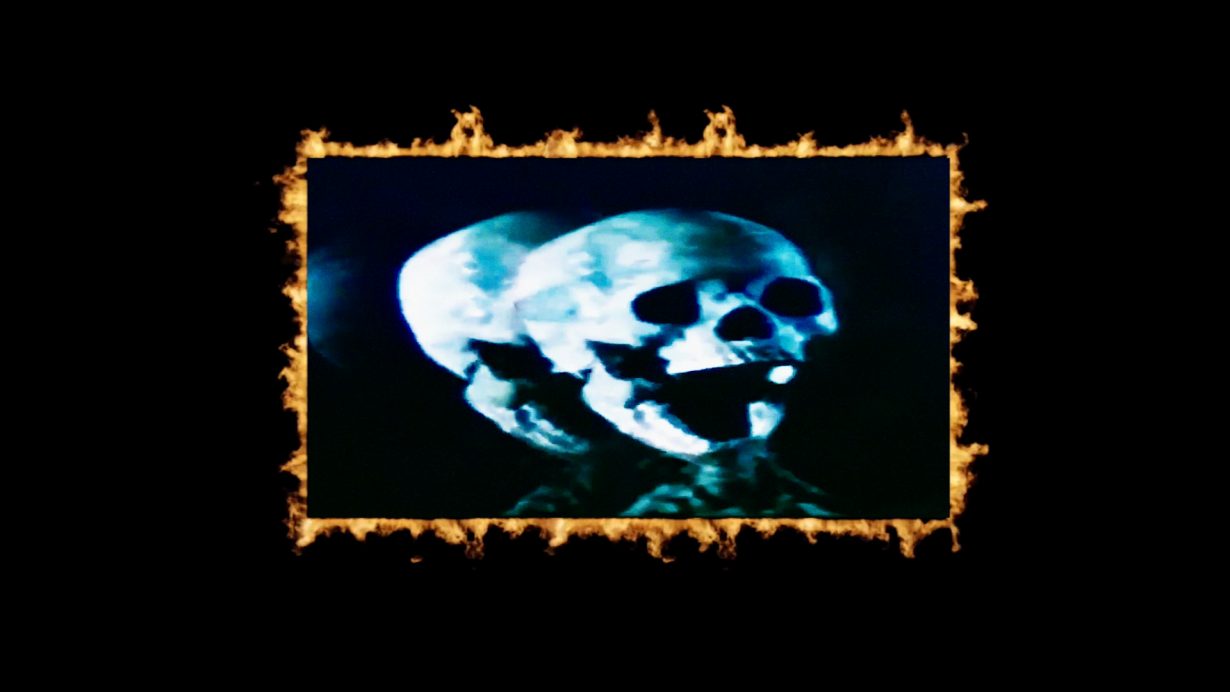
Misteri Bondowoso, proposes Ghost Like Us, illustrates “how cinema, notably horror, in Indonesia never had a chance to understand and build connection with the oppressed.” Rather, horror movies perpetuated what Paulo Freire coined as ‘magical consciousness’, where, as stated in the video, “people could not see the relation of their misery with the systematic violence in their political and cultural life,” due to the ideological structuring – or displacement – of the supernatural as a source of their suffering. But Misteri Bondowoso opened up a way through that impasse. Relating the film to media-theorist Jeffrey Sconce’s concept of the ‘electronic elsewhere’ (which, as Ghost Like Us puts, “is generated and accessed through the wonders of cinematic media and ritualistic practice”) and anthropologist Clifford Geertz’s description of the kyai (the Javanese name for teachers of Islam) as cultural brokers, Ghost Like Us concludes that Misteri Bondowoso created a bridge between rural worldviews and urban modern political engagement, traditional superstitions and metropolitan horror entertainment. Through that bridging, it offered “a method to rethink the role of cinematic apparatus and media technology in understanding politics, culture, technology, magic and social,” circling back to Rizaldi’s ruminations on reality as a composition of intersecting worldviews in Mirage.
There is a rootedness to Rizaldi’s expansive musings. Growing up he spent a lot of time in a public outdoor cinema in Gedebage market in the suburbs of Bandung, watching horror movies while his mother went to work. Formally, that experience has proven foundational, both in terms of Rizaldi’s engagement with the cinematic form and the immersive experience of cinema itself, since he did not experience cinema inside a black box. “It wasn’t an institutionalised building, like a theatre. It was outdoor, makeshift. I could throw peanuts at the screen if I hated the characters,” he recalls. “It was immersive and you actually shared a world with others as you experienced it.” That immersivity is palpable in Mirage: Eigenstate, where the capacity for moving images to open up portals is defined not only through their ability to articulate worlds, but through the amplification of the cinematic screen as a gateway to those worlds. Consider the scene where the shipwrecked cosmonaut enters another particle, and the shaman asks: “Are you ready to head towards the mirage?” Here, the mirage seems to be the thing that connects the desert, where Sufism originated, and the tropics, where humid air makes the concept of the god particle palpable as droplets we feel – an instant within which molecules combine to produce an image: a world of worlds.
Mirage is on view at Gasworks, London, through 22 December. Rizaldi’s work is also featured in Dream Screen at Leeum Museum of Art, Seoul, through 29 December; Your Ghosts Are Mine – Expanded Cinemas, Amplified Voices at Palazzo Cavalli-Franchetti, Venice, through 24 November; and Soils at Van Abbemuseum, Eindhoven, through 24 November
From the Winter 2024 issue of ArtReview Asia – get your copy.
